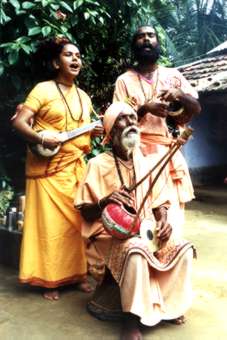 The
musical culture and life style of the Bauls has inspired
village life in Bengal so deeply that Bengali people
have protected Baul practitioners for many centuries.
Chaitanya Mahaprabhu (13th Century) was the greatest
known Baul singer, and he travelled all over India.
History counts him as the biggest influence among Baul
poets and singers of later generations.
The
musical culture and life style of the Bauls has inspired
village life in Bengal so deeply that Bengali people
have protected Baul practitioners for many centuries.
Chaitanya Mahaprabhu (13th Century) was the greatest
known Baul singer, and he travelled all over India.
History counts him as the biggest influence among Baul
poets and singers of later generations.
The
word " Baul " refers to three terms : betul,
which means " mad ", " out of rhythm " ; vayu,
" air ", or the inner flow of energy which gives life
and harmony to all sentient beings ; and âuliyâ,
a term of Arabic origin, which means " saint ", "
holy man ". Bauls can come from a Hindu or a Muslim
background ; in both cases, they are usually rebels
against orthodox practices and social institutions.
The reason of that is purely spiritual : they are
continuously searching for Adhar Manush, the " Essential
Man ", the inner being which is inside of each human
body, and this quest for mad love goes beyond all
boundaries.
The
way of the Bauls uses poetry, dance and singing as
tools to reach that goal. Therefore Bauls used to
wander from village to village and sing for the people
who would give them alms for the maintenance of their
everyday life. It is said that Bauls would accept
only what they needed and refuse anything more than
the strict minimum. Their only possessions were their
clothes and musical instruments, as well as their
songs and secret practices.
The
costume of the Bauls is very simple : many Bauls wear
safran clothes, a long stiched piece of cotton patchwork
covering their body from the shoulder to below the
knees, a turban on their head and a mark on their
forehead. As far as Fakir Bauls are concerned, they
prefer plain white cotton.
Even
today, most Bauls live in small huts ; they live in
couples but are not supposed to have children : mostly
they adopt abandoned children to whom they teach everything
they know. Twice a week, they go to villages to collect
food (mostly rice and vegetables). Sometimes they
travel from one village to another in order to meet
other practitioners. Most of them are also linked
to non-singing gurus who teach them different spiritual
practices (sadhana) and songs with an inner
meaning. The verses of Baul poetry can come from past
or present composers, and they always include secret
teachings related to righteous practice and life style.
The living space of Bauls is called akhra ;
it is somehow like an ashram, with the difference
that men and women live together, considering each
other as spiritual partners. Most akhras are
also meeting places for other sadhakas and
sadhikas, male and female practitioners, as
well as for sadhus, holy men, wherever they come from.
Each year, Bauls organise a big meeting where they
exchange songs, experiences and spiritual teachings.
Many
Baul gurus were and still are also poets ; Lalan Fakir,
one of the most famous of them, was at the same time
a revolutionary and a holy man ; he created more than
5000 such songs. In this poetry, the outer meaning
looks sometimes very materialistic ; but the inner
meaning, which is not accessible to everyone, includes
teachings related to notions such as srishti tattva
(doctrine of the creation of the world), atma tattva
(doctrine of the soul), deha tattva (doctrine
of the body), prem tattva (doctrine of love),
etc.
The
singing style of Bauls is linked to other Bengali
folk culture, from tribal to village and even urban
life. But Bauls have established their own singing
style, known as baul s¸r, within which individual
and regional styles sometimes remain very distinctive.
Bauls always sing and dance together in such a way
that the mind melts into the soul in a harmonious
way. In their dancing body, energy becomes fluid and
intense, and this movement process wipes the ego away
: only the Baul consciousness remains.
Baul
musical instruments
